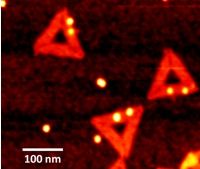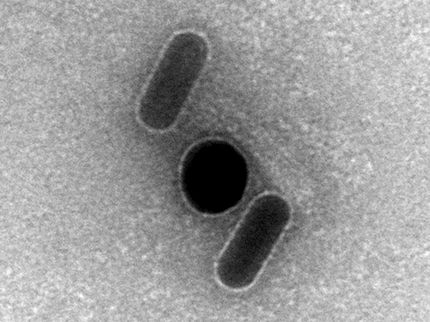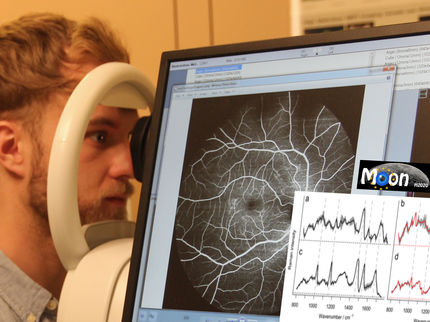Golden trap: Highly sensitive system to detect individual molecules
Advertisement
Medical diagnostics is searching for substances capable of documenting early on whether a serious disease is developing or what its course will be. In many cases, the treacherous molecules are present only in trace amounts – which is why extremely sensitive methods of detection are urgently needed. Now, researchers at the Helmholtz-Zentrum Dresden-Rossendorf (HZDR), along with scientists from Potsdam and Berlin, have come up with a new method of detection, which has allowed them to notice the presence of only 17 dye molecules. The highly sensitive method might one day be used to scan a tiny drop of blood for potential diseases.

This silicon surface is covered with triangular DNA origami each containing two gold nanoparticles the size of five nanometers. In-between them, single molecules can be trapped and detected.
Helmholtz-Zentrum Dresden-Rossendorf
The method's high sensitivity lies in the customized environment for the substance of interest. Dresden’s Adrian Keller and his colleagues have constructed a type of “golden trap” capable of capturing the molecules and thereby enabling their detection. To this end, they arranged two tiny gold particles onto a substrate at predetermined distances. Next, the scientists anchored molecules of a dye called TAMRA within these gaps. They then irradiated the sample using laser light, which yielded what is known as a Raman spectrum. This optical method involves laser light that is scattered from the molecule which produces a spectrum that is like a fingerprint for this particular substance. Normally, Raman spectroscopy is a method with rather low sensitivity and a large number of molecules is needed to ensure their detection. By contrast, if the molecules are located near metallic surfaces, an astonishing effect is observed: the Raman signal is greatly amplified.
Such was the effect the HZDR researchers observed in their sample. HZDR researcher Adrian Keller explains: “An electric field develops within the gap between the gold spheres. If you select the proper dimensions, the field gets enhanced and we end up with so-called hot spots.” Next, the electric field, along with the incoming laser light, excites the molecules, which leads to enhanced Raman scattering. In other words, if the molecules are bound within these hot spots, their characteristic signals can be particularly well identified in the spectrum.
To construct their golden trap, the scientists chose the genetic material DNA. Its thread-like strands can be folded into different objects with arbitrary dimensions using multiple shorter DNA segments. This technique, known as DNA origami, is based on the chemical binding of complementary bases – the DNA strands essentially interlock like the two rows of a zipper. This allowed Adrian Keller and his colleagues to construct DNA triangles with edge lengths of approximately 100 nanometers. Two precisely placed anchors protrude from such a triangle which is used to attach two gold nanoparticles at predefined spacing.
In a first experiment, the researchers coated the tiny gold spheres with a sort of “DNA fur” containing also dye molecules. They then took a Raman spectrum of the sample and found that the TAMRA molecules could easily be detected. Since the gold nanoparticles’ fur coat is rather dense, Adrian Keller and his colleagues estimate that between 100 and 1,000 TAMRA molecules ultimately contribute to the detected signal. In control experiments, the researchers irradiated the furry gold spheres with laser light without arranging them on the DNA triangle. Here, only a very weak signal was detectable in the spectrum.
Yet the method is much more sensitive than that. In other experiments, the researchers attached a pair of naked gold nanoparticles to a DNA triangle and connected three single dye molecules to the DNA using additional anchors that were localized directly within the hot spots. Also in these Raman spectra, the dye’s signal could easily be identified. The tiny gold spheres’ optimal size was determined to be 25 nanometers, a size where the enhancement effect was especially large.
Finally, Keller and his colleagues carefully inserted only a single dye molecule into the gap between the two gold particles. Even this vanishingly small amount of TAMRA could still be detected. The surface illuminated by the laser beam contained a total of 17 DNA triangles. In other words, the signal originated from 17 single molecules.
“We were able to show that this method basically allows us to detect single molecules,” says Adrian Keller. Now, the researchers are planning on further extending the setup. For example, they plan to attach an anchor in the gap between the gold particles, capable of binding a molecule of interest – such as a protein, for instance. This way, any type of biomolecule could be analyzed: DNA, RNA, or proteins. And since every class of molecule produces characteristic Raman signals, you can test for the presence of several substances at the same time using specially prepared DNA triangles. Going forward, this detection method could also be integrated into a chip and used in medical diagnostics.



















































